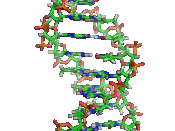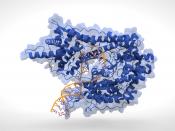DNA
Deoxyribonucleic acid and ribonucleic acid are two chemical substances involved in transmitting genetic
information from parent to offspring. It was known early into the 20th century that chromosomes, the genetic
material of cells, contained DNA. In 1944, Oswald T. Avery, Colin M. MacLeod, and Maclyn McCarty
concluded that DNA was the basic genetic component of chromosomes. Later, RNA would be proven to
regulate protein synthesis. (Miller, 139)
DNA is the genetic material found in most viruses and in all cellular organisms. Some viruses do not have
DNA, but contain RNA instead. Depending on the organism, most DNA is found within a single chromosome
like bacteria, or in several chromosomes like most other living things. (Heath, 110) DNA can also be found
outside of chromosomes. It can be found in cell organelles such as plasmids in bacteria, also in chloroplasts in
plants, and mitochondria in plants and animals.
All DNA molecules contain a set of linked units called nucleotides.
Each nucleotide is composed of three
things. The first is a sugar called deoxyribose. Attached to one end of the sugar is a phosphate group, and at
the other is one of several nitrogenous bases. DNA contains four nitrogenous bases. The first two, adenine and
guanine, are double-ringed purine compounds. The others, cytosine and thymine, are single-ringed pyrimidine
compounds. (Miller, 141) Four types of DNA nucleotides can be formed, depending on which nitrogenous
base is involved.
The phosphate group of each nucleotide bonds with a carbon from the deoxyribose. This forms what is called
a polynucleotide chain. James D. Watson and Francis Crick proved that most DNA consists of two
polynucleotide chains that are twisted together into a coil, forming a double helix. Watson and Crick also
discovered that in a double helix, the pairing between bases of the two chains...


